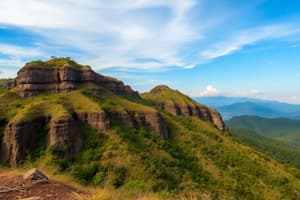Podcast
Questions and Answers
What is the primary geology of karst landscapes where ponors are found?
What is the primary geology of karst landscapes where ponors are found?
- Sandstone rock
- Porous limestone rock (correct)
- Shale rock
- Granite rock
What is the origin of the word 'ponor' in Croatian and Slovene?
What is the origin of the word 'ponor' in Croatian and Slovene?
- From the Latin word for 'water'
- From the proto-Slavic word 'nora', meaning 'pit', 'hole', 'abyss' (correct)
- From the French word for 'spring'
- From the Greek word for 'cave'
What is the main difference between a ponor and a sinkhole?
What is the main difference between a ponor and a sinkhole?
- A ponor is larger than a sinkhole
- A ponor is a depression of surface topography with a pit or cavity underneath
- A ponor is a portal where a surface stream or lake flows into a karst groundwater system (correct)
- A ponor is formed only in granite rock
In which countries can places with the name Ponor be found?
In which countries can places with the name Ponor be found?
What can ponors do to stream or lake water?
What can ponors do to stream or lake water?
What can cause the formation or enlargement of a ponor?
What can cause the formation or enlargement of a ponor?
Flashcards are hidden until you start studying
Study Notes
Characteristics of Ponors
- Ponors are natural openings where surface water flows into underground passages in karst landscapes.
- They are typically found in areas with porous limestone rock.
Features of Ponors
- Can be large pits and caves, large fissures and caverns, networks of smaller cracks, and sedimentary, alluvial drains.
- May drain stream or lake water continuously or work as springs at times.
Etymology of Ponor
- The word "ponor" comes from the Croatian and Slovene language, derived from the proto-Slavic word "nora", meaning pit, hole, or abyss.
- The English word "narrow" possibly has the same origin.
Geographical Occurrences
- Places in southeast Europe (Bulgaria, Croatia, Czech Republic, Hungary, Romania, Montenegro, Slovenia) are named Ponor due to associated karst openings.
Distinction from Sinkholes
- Unlike sinkholes (dolines), which are surface depressions with a pit or cavity underneath, ponors are portals where surface streams or lakes flow partially or completely underground into a karst groundwater system.
Formation of Ponors
- Steady water erosion may have formed or enlarged ponors in limestone rock, conglomerates, or looser materials.
Karst Terrains and Ponors
- Karst terrains are known for surface water losses through small ponors, which resurge after traveling through vast underground systems.
Studying That Suits You
Use AI to generate personalized quizzes and flashcards to suit your learning preferences.




